The global green chemicals market is expected to grow from USD 14.2 billion in 2025 to approximately USD 30.2 billion by 2035, recording an absolute increase of USD 16.0 billion over the forecast period. This translates into a total growth of 112.0%, with the market forecast to expand at a compound annual growth rate (CAGR) of 7.8% between 2025 and 2035. The overall market size is expected to grow by nearly 2.1X during the same period, supported by increasing environmental regulations, rising demand for sustainable alternatives, and growing focus on carbon footprint reduction and circular economy principles.
Between 2025 and 2030, the green chemicals market is projected to expand from USD 14.2 billion to USD 20.6 billion, resulting in a value increase of USD 6.4 billion, which represents 40% of the total forecast growth for the decade. This phase of growth will be shaped by stringent environmental regulations, increasing corporate sustainability commitments, and growing adoption of bio-based feedstocks in chemical manufacturing. Chemical manufacturers are expanding their green product portfolios to address the growing demand for environmentally friendly alternatives across various industrial applications.
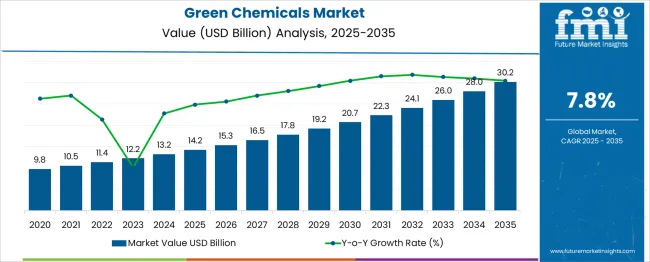
| Metric | Value |
|---|---|
| Estimated Value in (2025E) | USD 14.2 billion |
| Forecast Value in (2035F) | USD 30.2 billion |
| Forecast CAGR (2025 to 2035) | 7.8% |
From 2030 to 2035, the market is forecast to grow from USD 20.6 billion to USD 30.2 billion, adding another USD 9.6 billion, which constitutes 60.0% of the overall ten-year expansion. This period is expected to be characterized by technological advancements in biotechnology, expansion of renewable feedstock availability, and development of cost-competitive green chemical solutions. The growing adoption of circular economy principles and zero-waste manufacturing will drive demand for innovative green chemicals with enhanced performance and sustainability profiles.
Between 2020 and 2025, the green chemicals market experienced significant expansion, driven by increasing regulatory pressure for environmental compliance and growing corporate commitments to sustainability goals. The market developed as chemical manufacturers recognized the need for sustainable alternatives to petroleum-based chemicals. Government incentives and consumer demand for eco-friendly products began emphasizing the importance of green chemicals in achieving carbon neutrality and environmental protection objectives.
Market expansion is being supported by the increasing global focus on environmental sustainability and the corresponding demand for eco-friendly chemical alternatives. Industries worldwide are increasingly adopting green chemicals to meet stringent environmental regulations, reduce carbon emissions, and achieve sustainability targets. The proven performance of bio-based chemicals in various applications, coupled with improving cost competitiveness, makes them attractive alternatives to conventional petroleum-based chemicals.
The growing emphasis on circular economy principles and renewable resources is driving demand for green chemicals derived from biomass, agricultural waste, and other sustainable feedstocks. Industrial preference for products that reduce environmental impact while maintaining performance standards is creating opportunities for innovative green chemical formulations. The rising influence of corporate sustainability initiatives and ESG (Environmental, Social, and Governance) investing is also contributing to increased adoption across different industrial sectors.
The market is segmented by product outlook and application outlook. By product outlook, the market is divided into bio-alcohols, bio-organic acids, biopolymers, and other products. Based on application outlook, the market is categorized into construction, pharmaceuticals, packaging, food and beverages, paints and coatings, automotive, textile, and other applications. Regionally, the market is divided into North America, Europe, East Asia, South Asia & Pacific, Latin America, and Middle East & Africa.
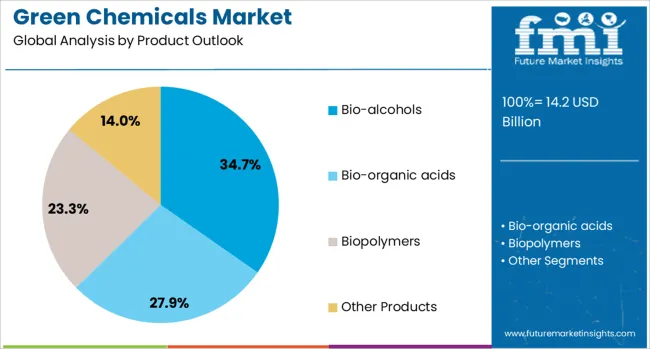
The bio-alcohols segment is projected to account for 34.7%of the green chemicals market in 2025, reaffirming its position as the category's leading product type. Industries increasingly recognize bio-alcohols as versatile, sustainable alternatives to petroleum-based alcohols, with applications ranging from solvents and fuels to chemical intermediates. The segment benefits from established production technologies, particularly for bioethanol and biomethanol, which have achieved commercial scale and cost competitiveness.
This product category forms the foundation of many green chemistry initiatives, as bio-alcohols represent the most mature and widely adopted green chemical solutions. Growing demand from the transportation sector for biofuels, coupled with increasing use in personal care and pharmaceutical industries, continues to strengthen market position. With production technologies advancing and feedstock availability improving, bio-alcohols maintain broad appeal across industrial applications, ensuring sustained dominance and making them the central growth driver of green chemicals demand.
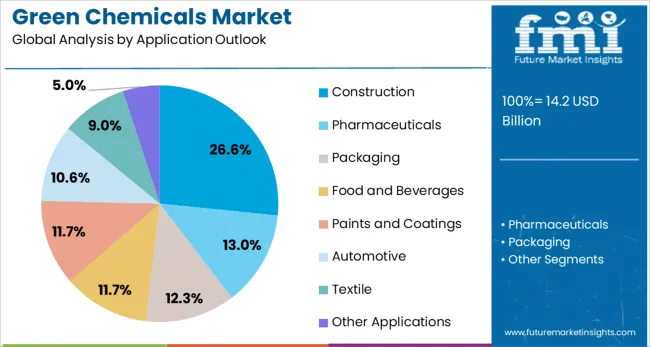
Construction applications are projected to represent 26.6%of green chemicals demand in 2025, underscoring the industry's commitment to sustainable building practices and environmental responsibility. The construction sector increasingly adopts green chemicals for various applications including bio-based adhesives, sealants, insulation materials, and concrete additives. These sustainable alternatives offer comparable performance to conventional chemicals while significantly reducing environmental impact and improving indoor air quality.
The segment is supported by green building certification programs such as LEED and BREEAM, which incentivize the use of environmentally friendly materials. Additionally, regulatory requirements for volatile organic compound (VOC) reduction and increasing demand for energy-efficient buildings are driving adoption of green chemical solutions. As the construction industry continues to prioritize sustainability and carbon footprint reduction, green chemicals will maintain their critical role in achieving environmental objectives while meeting performance requirements.
The green chemicals market is advancing rapidly due to increasing environmental regulations and growing demand for sustainable industrial solutions. However, the market faces challenges including higher production costs compared to conventional chemicals, limited feedstock availability, and technical performance gaps in certain applications. Innovation in biotechnology and process optimization continue to influence product development and market expansion patterns.
The continuous improvement in biotechnology and fermentation processes is enabling more efficient production of green chemicals from renewable feedstocks. Advanced bioprocessing techniques, including synthetic biology and metabolic engineering, are improving yields and reducing production costs. These technological developments are making green chemicals increasingly competitive with petroleum-based alternatives while expanding the range of available bio-based products.
Modern green chemical manufacturers are incorporating circular economy principles throughout their value chains, from feedstock sourcing to end-of-life management. This includes utilizing agricultural waste and industrial by-products as raw materials, developing biodegradable products, and implementing closed-loop recycling systems. These approaches not only reduce environmental impact but also create new value streams and improve overall sustainability performance.
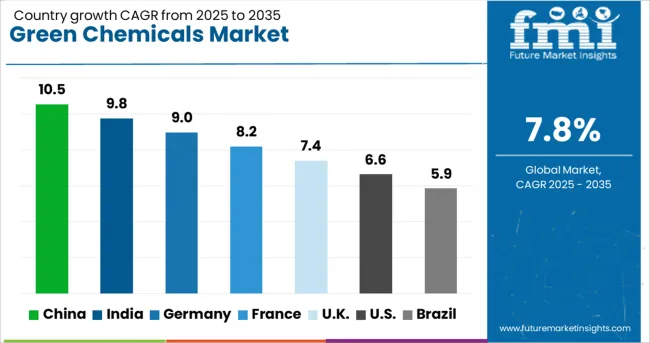
| Country | CAGR (2025 to 2035) |
|---|---|
| China | 10.5% |
| India | 9.8% |
| Germany | 9% |
| France | 8.2% |
| UK | 7.4% |
| USA | 6.6% |
| Brazil | 5.9% |
The green chemicals market is experiencing robust growth globally, with China leading at a 10.5% CAGR through 2035, driven by massive industrial scale, government support for green technologies, and increasing environmental regulations. India follows at 9.8%, supported by growing industrial base, agricultural feedstock availability, and sustainability initiatives. Germany shows strong growth at 9%, emphasizing technological innovation and circular economy implementation. France records 8.2%, focusing on biorefinery development and agricultural valorization. The UK shows 7.4% growth, prioritizing innovation and sustainable chemistry research. The USA demonstrates 6.6% growth with established bio-based chemical infrastructure, while Brazil leverages its agricultural resources with 5.9% growth.
The report covers an in-depth analysis of 40+ countries; seven top-performing countries are highlighted below.
Revenue from green chemicals in China is projected to exhibit strong growth with a CAGR of 10.5% through 2035, driven by massive industrial demand, stringent environmental regulations, and substantial government investment in sustainable technologies. The country's commitment to carbon neutrality by 2060 and increasing pressure to reduce industrial pollution are creating significant demand for green chemical alternatives. Major domestic and international chemical companies are establishing bio-based production facilities to serve the growing demand for sustainable chemicals across various industrial sectors.
Revenue from green chemicals in India is expanding at a CAGR of 9.8%, supported by abundant agricultural feedstock, growing industrial base, and increasing focus on sustainable development. The country's large agricultural sector provides diverse biomass resources for green chemical production, while government initiatives promote bio-based industrial development. Both domestic manufacturers and multinational corporations are investing in green chemical production facilities to serve growing domestic and export markets.
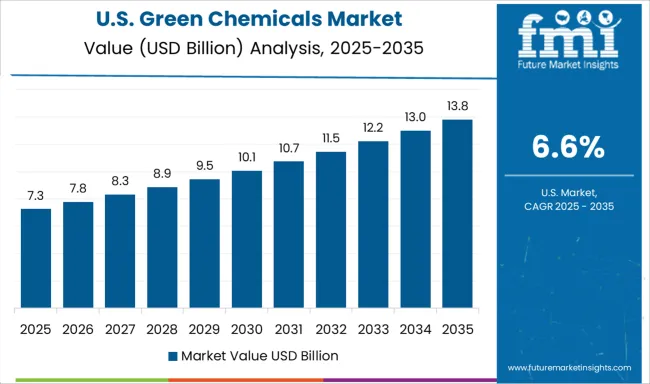
Demand for green chemicals in the USA is projected to grow at a CAGR of 6.6%, supported by mature bio-based chemical industry, strong research infrastructure, and corporate sustainability commitments. American companies are at the forefront of green chemical innovation, developing advanced biotechnology solutions and commercial-scale production facilities. The market benefits from established supply chains, technological expertise, and growing demand from environmentally conscious consumers and businesses.

Revenue from green chemicals in Germany is projected to grow at a CAGR of 9% through 2035, driven by the country's strong chemical industry base, commitment to environmental sustainability, and technological innovation capabilities. German chemical companies are leading development of advanced green chemical technologies, combining traditional chemical expertise with biotechnology innovations.
Revenue from green chemicals in France is projected to grow at a CAGR of 8.2% through 2035, supported by strategic focus on bioeconomy development, agricultural resources utilization, and industrial biotechnology advancement. French companies are developing integrated biorefineries that maximize value extraction from biomass feedstocks.
Revenue from green chemicals in the UK is projected to grow at a CAGR of 7.4% through 2035, supported by strong research capabilities, innovation ecosystem, and commitment to net-zero emissions. British companies and research institutions are developing novel green chemical technologies and sustainable production processes.
Revenue from green chemicals in Brazil is projected to grow at a CAGR of 5.9% through 2035, supported by abundant agricultural resources, established bioethanol industry, and growing focus on bioeconomy development. Brazilian companies are leveraging sugarcane and other agricultural feedstocks to produce various green chemicals.
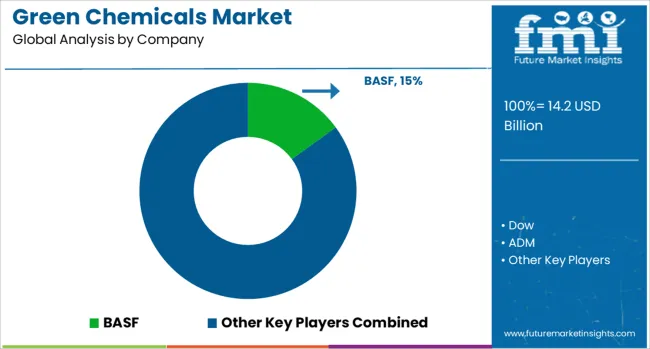
The green chemicals market is characterized by competition among established chemical giants, specialized biotechnology companies, and emerging green technology players. Companies are investing in biotechnology platforms, renewable feedstock sourcing, production scale-up, and strategic partnerships to deliver cost-effective, high-performance, and sustainable chemical solutions. Technology innovation, feedstock security, and market development are central to strengthening product portfolios and market presence.
BASF SE, Germany-based, leads the market with 15.0% global value share, offering comprehensive green chemical portfolio with focus on bio-based intermediates and specialty chemicals. The company leverages its extensive research capabilities and global production network to develop sustainable alternatives across various chemical categories. The Dow Chemical Company (Dow Inc.), USA, provides innovative bio-based solutions with emphasis on performance materials and circular economy principles. ADM, USA, utilizes its agricultural processing expertise to produce bio-based chemicals from renewable feedstocks.
Cargill Incorporated, USA, focuses on industrial biotechnology and fermentation-based production of green chemicals. Corbion, Netherlands, specializes in lactic acid and bio-based chemicals for various applications. Merck KGaA, Germany, offers specialty green chemicals for pharmaceutical and life science applications. Syensqo develops advanced materials and specialty chemicals with sustainability focus. Solugen pioneers enzyme-based chemical production technology. Evonik Industries AG provides specialty green chemicals with focus on performance and sustainability. Mitsubishi Chemical Group Corporation develops comprehensive green chemical portfolio combining Japanese technology excellence with global market reach.
| Items | Values |
|---|---|
| Quantitative Units (2025) | USD 14.2 billion |
| Product Outlook | Bio-alcohols, Bio-organic acids, Biopolymers, Other Products |
| Application Outlook | Construction, Pharmaceuticals, Packaging, Food and Beverages, Paints and Coatings, Automotive, Textile, Other Applications |
| Regions Covered | North America, Europe, East Asia, South Asia & Pacific, Latin America, Middle East & Africa |
| Countries Covered | United States, Canada, United Kingdom, Germany, France, China, Japan, South Korea, India, Brazil, Australia and 40+ countries |
| Key Companies Profiled | BASF SE, The Dow Chemical Company (Dow Inc.), ADM, Cargill Incorporated, Corbion, Merck KGaA, Syensqo, Solugen, Evonik Industries AG, and Mitsubishi Chemical Group Corporation |
| Additional Attributes | Dollar sales by product type and application sector, regional demand trends, competitive landscape, buyer preferences for bio-based versus synthetic alternatives, integration with circular economy principles, innovations in biotechnology, fermentation processes, and sustainable feedstock utilization |
The global green chemicals market is estimated to be valued at USD 14.2 billion in 2025.
The market size for the green chemicals market is projected to reach USD 30.2 billion by 2035.
The green chemicals market is expected to grow at a 7.8% CAGR between 2025 and 2035.
The key product types in green chemicals market are bio-alcohols, bio-organic acids, biopolymers and other products.
In terms of application outlook, construction segment to command 26.6% share in the green chemicals market in 2025.






Our Research Products

The "Full Research Suite" delivers actionable market intel, deep dives on markets or technologies, so clients act faster, cut risk, and unlock growth.

The Leaderboard benchmarks and ranks top vendors, classifying them as Established Leaders, Leading Challengers, or Disruptors & Challengers.

Locates where complements amplify value and substitutes erode it, forecasting net impact by horizon

We deliver granular, decision-grade intel: market sizing, 5-year forecasts, pricing, adoption, usage, revenue, and operational KPIs—plus competitor tracking, regulation, and value chains—across 60 countries broadly.

Spot the shifts before they hit your P&L. We track inflection points, adoption curves, pricing moves, and ecosystem plays to show where demand is heading, why it is changing, and what to do next across high-growth markets and disruptive tech

Real-time reads of user behavior. We track shifting priorities, perceptions of today’s and next-gen services, and provider experience, then pace how fast tech moves from trial to adoption, blending buyer, consumer, and channel inputs with social signals (#WhySwitch, #UX).

Partner with our analyst team to build a custom report designed around your business priorities. From analysing market trends to assessing competitors or crafting bespoke datasets, we tailor insights to your needs.
Supplier Intelligence
Discovery & Profiling
Capacity & Footprint
Performance & Risk
Compliance & Governance
Commercial Readiness
Who Supplies Whom
Scorecards & Shortlists
Playbooks & Docs
Category Intelligence
Definition & Scope
Demand & Use Cases
Cost Drivers
Market Structure
Supply Chain Map
Trade & Policy
Operating Norms
Deliverables
Buyer Intelligence
Account Basics
Spend & Scope
Procurement Model
Vendor Requirements
Terms & Policies
Entry Strategy
Pain Points & Triggers
Outputs
Pricing Analysis
Benchmarks
Trends
Should-Cost
Indexation
Landed Cost
Commercial Terms
Deliverables
Brand Analysis
Positioning & Value Prop
Share & Presence
Customer Evidence
Go-to-Market
Digital & Reputation
Compliance & Trust
KPIs & Gaps
Outputs
Full Research Suite comprises of:
Market outlook & trends analysis
Interviews & case studies
Strategic recommendations
Vendor profiles & capabilities analysis
5-year forecasts
8 regions and 60+ country-level data splits
Market segment data splits
12 months of continuous data updates
DELIVERED AS:
PDF EXCEL ONLINE
Green and Bio-based Polyol Market Size and Share Forecast Outlook 2025 to 2035
Green Ammonia Market Size and Share Forecast Outlook 2025 to 2035
Green Cement Market Size and Share Forecast Outlook 2025 to 2035
Green Power Market Size and Share Forecast Outlook 2025 to 2035
Green Power Transformer Market Size and Share Forecast Outlook 2025 to 2035
Green Preservatives Market Size and Share Forecast Outlook 2025 to 2035
Green Tea Supplements Market Analysis - Size, Share, and Forecast 2025 to 2035
Green Data Center Market Size and Share Forecast Outlook 2025 to 2035
Green Logistics Market Size and Share Forecast Outlook 2025 to 2035
Green Methanol Market Size and Share Forecast Outlook 2025 to 2035
Green Technology And Sustainability Market Size and Share Forecast Outlook 2025 to 2035
Greenwrap Market Analysis - Size, Share, and Forecast Outlook 2025 to 2035
Green Coatings Market Analysis by Technology, Application, and Region Forecast through 2035
Green Building Materials Market Analysis by Type, Application, End-user and Region: Forecast for 2025 and 2035
Green UPS Market - Trends & Forecast 2025 to 2035
Green Tire Market Growth – Trends & Forecast 2025 to 2035
Green Tea Extracts Market Analysis – Size, Share & Forecast 2025 to 2035
Green Banana Flour Market Analysis - Growth & Demand 2025 to 2035
Green Transformer Market Growth – Trends & Forecast 2025 to 2035
Green Electronics Manufacturing Market – Sustainability & Trends 2025 to 2035

Thank you!
You will receive an email from our Business Development Manager. Please be sure to check your SPAM/JUNK folder too.
Chat With
MaRIA